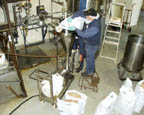
With that in mind, TFF recently explored ways to increase the rapid dispersion of gums to improve turnaround time and streamline its flavor manufacturing process.
"Flavor emulsions are one of our specialties and a core part of our product line," says Dinetmann. "That's why we believed a process improvement here could produce an enormous benefit for our clients."
TFF uses a variety of gums to produce its flavor emulsions. The gums are broken down and dispersed in a water-based solution, which enables them to encapsulate the flavor droplets and stabilize emulsion. The tough part, according to Dinetmann, is dispersing the gum quickly and reducing the particles to a very small, uniform size.
"Gums are notoriously difficult to wet out," he says. "In the first phase of our process we were mixing with a high speed rotor/stator mixer in a 350-gallon open-head type vessel. Even with a lot of turbulence, the gums would float on the surface and resist wetting out. It typically required up to six hours before all the powders were added." After they were processed through a homogenizer, particle sizes averaged 0.4-0.6µm with two to three passes.
The plant also charged ingredients from an overhead platform/mezzanine, which created another serious problem - dusting. "It was really noticeable when we added colors. The fine color particles would become airborne, creating a potential hazard and a mess that required hours to clean up," says Dinetmann.
To help, TFF's development team selected a SLIM in-line rotor/stator powder injection system from Charles Ross & Son. The system combines the gum with a fast-moving liquid stream under intense shear. "The gum is dispersed instantly," says Dinetmann, "with no floating, foaming or delays. It's then recirculated under the liquid level in the vessel until all of the powder has been added."
The efficiency TFF gained as a result of the equipment has been significant. Despite heavy solids loading (18-30% solids by weight), the process was shortened to two hours. And, the closed in-line system eliminated the dusting problem. "We can now handle several 1,000-gallon vessels as well as the open-head tank with a single injection system that wheels from one vessel to another," says Dinetmann. The company also found that after processing through the SLIM system, its average particle size prior to homogenization was much smaller and more uniform than before. As a result, the plant has been able to cut its passes through the homogenizer from two to three down to one to two.
With these changes in place, TFF has been able to cut its turnaround time by days. "We live in a world where every additional hour can be critical," says Dinetmann, "and these improvements give us a terrific advantage."
For more information:
Doug Cohen, Charles Ross & Son, dcohen@mixers.com,
800-343-ROSS